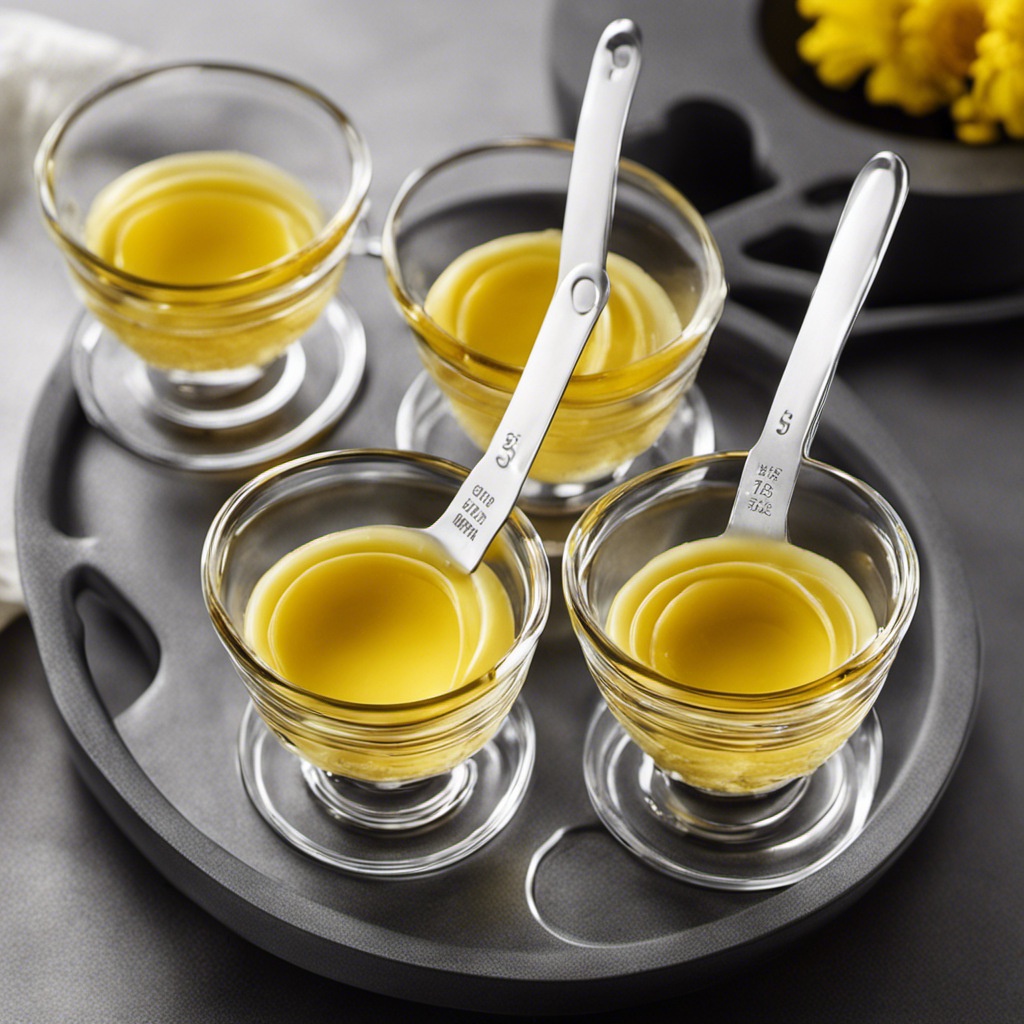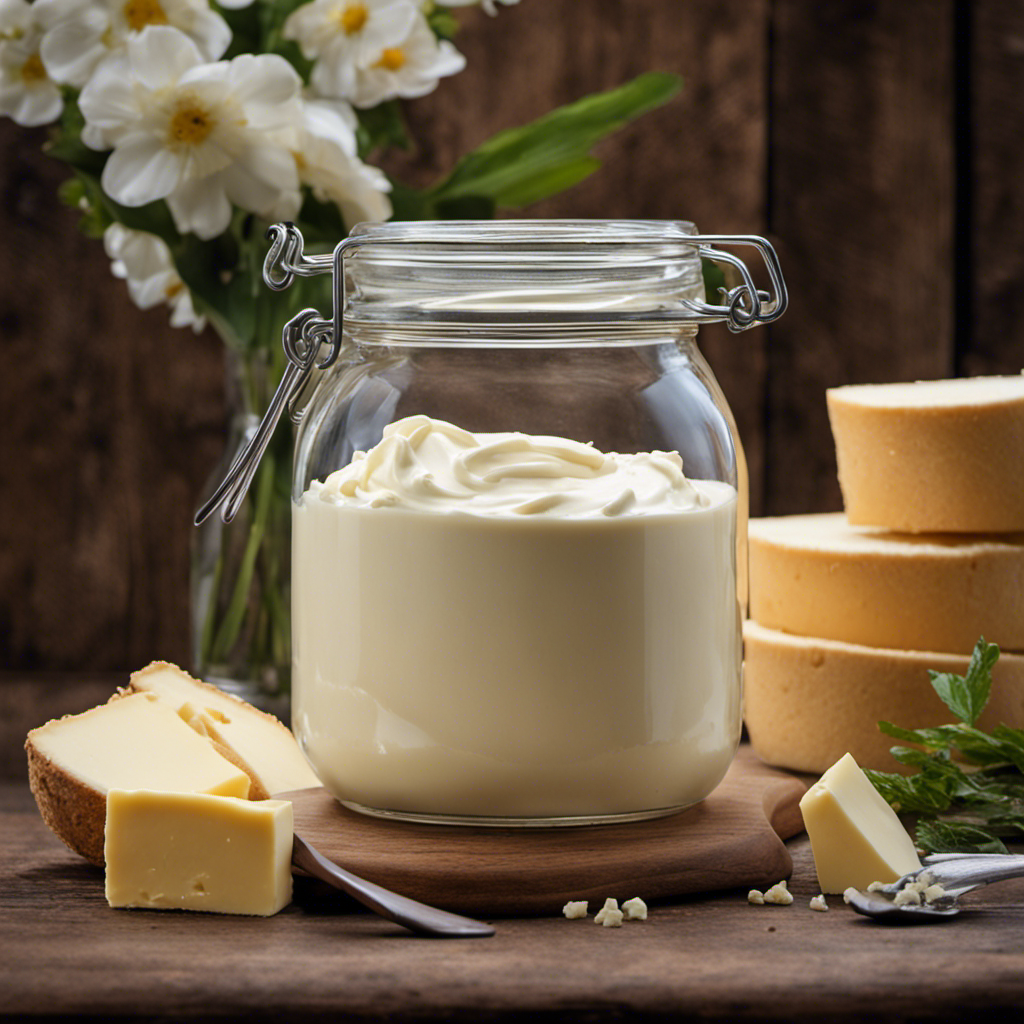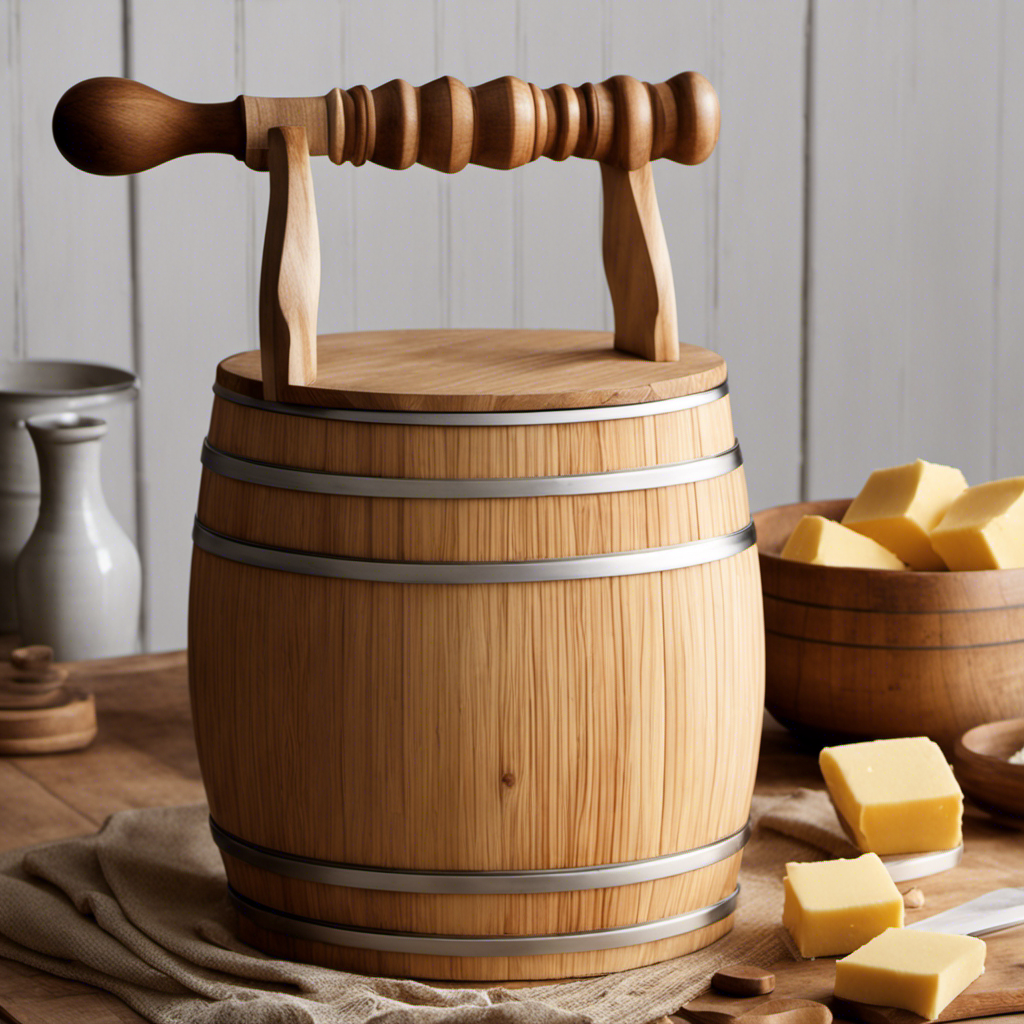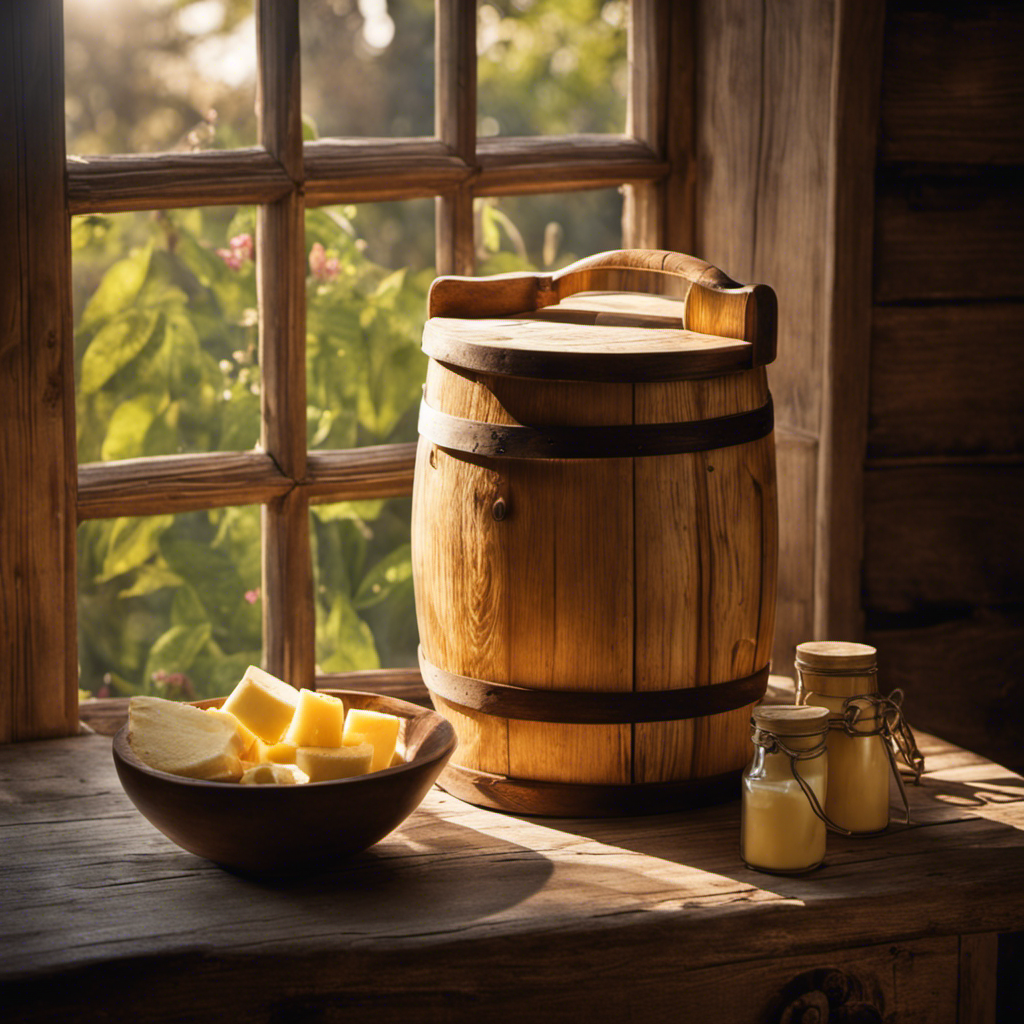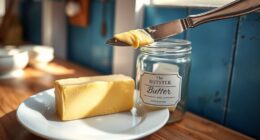I’ve always been curious about how many teaspoons are in 1/3 cup of butter. It’s a measurement that frequently appears in recipes, but I’ve never been able to recall the exact conversion.
So, I decided to dive into the world of accurate measurements and butter conversions to find the answer. In this article, I will break down the process of converting cups to teaspoons and calculate the precise number of teaspoons in 1/3 cup of butter.
Get ready to take your baking skills to the next level!
Key Takeaways
- Accurate measurements are crucial in baking to achieve the desired texture, taste, and consistency.
- Measuring butter in grams provides a more precise measurement due to the different forms and densities of butter.
- Conversion tables and tools can help adjust measurements between cups and teaspoons.
- Using standardized measuring spoons and paying attention to conversion techniques ensures accuracy in measurements.
The Importance of Accurate Measurements
Accurate measurements are crucial when baking because they ensure the right balance of ingredients. Precision is key in achieving the desired texture, taste, and consistency in baked goods. Measuring ingredients correctly is a fundamental skill that every baker should master.
Whether it’s flour, sugar, butter, or liquids, using the correct measurements ensures that the recipe will turn out as intended. Too much or too little of an ingredient can throw off the entire recipe, resulting in a failed bake. Baking is a science, and precise measurements are essential for accurate results.
Measuring cups, spoons, and kitchen scales are indispensable tools for achieving this precision. By following recipes and measuring ingredients correctly, we can create delicious and successful baked goods every time.
Understanding Butter Measurements
To understand how to measure butter, you’ll need to know the conversion from teaspoons to cups.
Butter measurements can vary depending on its consistency, which can affect the accuracy of your recipe. It’s important to have a clear understanding of how to measure butter in grams, as this is a more precise and consistent way to measure it.
Here are three key points to consider when measuring butter:
-
Butter consistency: Butter can come in different forms, such as sticks, blocks, or tubs. Each form may have a different density, which can affect the volume when measuring. It’s essential to follow the recipe guidelines for the specific form of butter you are using.
-
Conversion to grams: Measuring butter in grams provides a more accurate measurement than using teaspoons or cups. Use a kitchen scale to weigh the butter to ensure precise measurements.
-
Adjusting for different measurements: If a recipe calls for a specific measurement of butter in grams, but you only have it in teaspoons or cups, you can convert the measurement using online conversion tools or reference charts.
Converting Cups to Teaspoons
When converting cups to teaspoons, it’s helpful to remember that there are 48 teaspoons in one cup. This conversion can be useful when following recipes or determining the amount of an ingredient needed. Additionally, understanding how to convert between different units of measurement can save time and ensure accurate results. To further illustrate this conversion, I have created a table below that shows the equivalent teaspoons for various cup measurements.
| Cup Measurement | Teaspoon Equivalent |
|---|---|
| 1/4 cup | 12 teaspoons |
| 1/2 cup | 24 teaspoons |
| 3/4 cup | 36 teaspoons |
| 1 cup | 48 teaspoons |
| 2 cups | 96 teaspoons |
Converting cups to tablespoons follows a similar logic, as there are 16 tablespoons in one cup. For example, if you have 1/4 cup of butter, you can convert it to tablespoons by multiplying the cup measurement by 16, resulting in 4 tablespoons. Similarly, converting tablespoons to teaspoons can be done by multiplying the tablespoon measurement by 3, as there are 3 teaspoons in one tablespoon.
The Ratio of Teaspoons to Cups
When it comes to converting teaspoons to cups, accuracy is crucial. This is because even a slight miscalculation can lead to incorrect measurements and affect the final outcome of a recipe.
Understanding the ratio of teaspoons to cups is not only important for cooking and baking, but it also has practical applications in various fields, such as chemistry and medicine, where precise measurements are essential for accurate results.
Conversion Accuracy of Teaspoons
The accuracy of teaspoons in converting measurements is crucial in determining how many teaspoons are in 1/3 cup of butter. When it comes to converting between teaspoons and cups, there are a few conversion techniques to keep in mind.
It is important to note that common measurement mistakes can lead to inaccurate results. To ensure accuracy, consider the following:
- Use standardized measuring spoons: Different brands may have slight variations in teaspoon size.
- Level off the measurement: When measuring butter, make sure to level off the top of the spoon to get an accurate amount.
- Understand the conversion factor: 1 cup is equal to 48 teaspoons, so 1/3 cup would be approximately 16 teaspoons.
By paying attention to these conversion techniques and avoiding common measurement mistakes, you can accurately determine how many teaspoons are in 1/3 cup of butter.
This understanding of ratios and conversions has practical applications in various culinary endeavors.
Practical Applications of Ratio
To apply ratios practically, you can use them in different culinary endeavors. For instance, when baking, ratios are essential for ensuring accurate measurements of ingredients. Real life examples of using ratios for baking recipes include adjusting the quantity of ingredients based on the desired serving size.
To calculate ingredient measurements when adjusting recipes for different serving sizes, you can use ratios to scale up or down the quantities. For example, if a recipe calls for 1 cup of flour and you want to make a smaller batch, you can use a ratio to determine the appropriate amount of flour. By using ratios, you can ensure that the proportions of ingredients remain consistent, resulting in a successful final product.
Now, let’s explore how ratios can help us in calculating teaspoons in 1/3 cup of butter.
Calculating Teaspoons in 1/3 Cup of Butter
When it comes to baking, accurately measuring ingredients is crucial for achieving the desired results.
One key ingredient often used in baking is butter, and knowing the conversion ratio for butter can help ensure precision in recipes.
For example, understanding that there are 48 teaspoons in 1 cup of butter allows us to calculate that there are approximately 16 teaspoons in 1/3 cup of butter.
Conversion Ratio for Butter
Did you know that there are 16 teaspoons in 1/3 cup of butter? When it comes to conversion techniques and butter equivalents, it is important to have a clear understanding of the ratios involved. Here are three key points to keep in mind:
-
Butter is commonly measured in cups, tablespoons, and teaspoons. Understanding the conversion ratios between these units is essential for accurate measurements in cooking and baking.
-
One cup of butter is equal to 48 teaspoons. This means that if you need to convert 1/3 cup of butter to teaspoons, you simply multiply 1/3 by 48, resulting in 16 teaspoons.
-
Knowing these conversion ratios allows you to easily adjust recipes according to your needs or preferences, ensuring that your dishes turn out just right.
Now that we have established the conversion ratio for butter, let’s explore in more detail the number of teaspoons in 1/3 cup.
Teaspoons in 1/3 Cup
Understanding the ratios involved is crucial for accurately measuring butter equivalents in cooking and baking. When it comes to converting butter measurements, teaspoons are commonly used. To help you navigate the world of butter measurement techniques, let’s take a look at how many teaspoons are in 1/3 cup of butter.
| Cup (c) | Tablespoon (tbsp) | Teaspoon (tsp) |
|---|---|---|
| 1 | 16 | 48 |
| 1/2 | 8 | 24 |
| 1/3 | 5 1/3 | 16 |
From the table above, we can see that 1/3 cup of butter is equal to approximately 16 teaspoons. This conversion can come in handy when following a recipe that requires precise measurements. By understanding the ratios, you can ensure that your dishes turn out just right.
Measuring Butter Accurately
Knowing the correct ratios is crucial for accurately measuring butter equivalents in recipes. When it comes to measuring butter alternatives, it is important to be aware of some common mistakes that can affect the outcome of your culinary creations. Here are three key points to keep in mind:
-
Using the wrong measurement tool: Many people mistakenly use liquid measuring cups to measure solid butter. This can lead to inaccurate measurements, as the volume of solid butter differs from its melted form.
-
Not accounting for density: Different types of butter alternatives have varying densities. For example, margarine is less dense than butter. Therefore, it is important to adjust the measurements accordingly to ensure accurate results.
-
Ignoring temperature: Butter alternatives should be measured at the recommended temperature stated in the recipe. Measuring butter when it is too cold or too soft can affect the texture and consistency of your dish.
Understanding these common mistakes will help you achieve more precise measurements when using butter alternatives in your recipes. Now, let’s move on to some useful tips for measuring butter accurately.
Tips for Measuring Butter
To accurately measure butter, you’ll want to soften it first for easier scooping. Softening the butter allows it to be more pliable and easier to work with when measuring. This can be done by leaving the butter at room temperature for about 30 minutes or by using a microwave on low power for short intervals.
Once the butter is softened, you can use a measuring spoon or scale to measure the desired amount. It is important to note that measuring butter alternatives, such as margarine or shortening, may require different techniques as their consistency and density may vary.
Common mistakes when measuring butter include using a dry measuring cup instead of a liquid measuring cup, not properly leveling off the measurement, or not using the correct conversion for different units of measurement.
Adjusting Recipes for Different Butter Measurements
If you’re using a different type of fat in your recipe, such as margarine or shortening, you’ll need to make adjustments to ensure the proper consistency and taste. Adjusting recipe ratios is crucial when substituting butter with other fats.
Here are some tips to help you make accurate adjustments:
-
Use a conversion chart or online calculator to determine the equivalent amount of the substitute fat. Different fats have different densities, so a cup of margarine may not weigh the same as a cup of butter.
-
Consider the moisture content of the substitute fat. Butter contains about 80% fat and 20% water, so if your substitute is low in moisture, you may need to add extra liquid to the recipe.
-
Take note of the flavor of the substitute fat. Butter has a distinct taste that can enhance the flavor of baked goods. If your substitute is flavorless, you may need to add extra flavorings to compensate.
Frequently Asked Questions
Can I Use Margarine Instead of Butter in This Measurement Conversion?
Yes, you can use margarine instead of butter in this measurement conversion. However, there are pros and cons to consider. Margarine is lower in saturated fat but may affect the taste and texture of baked goods.
How Do I Convert Tablespoons to Teaspoons When Measuring Butter?
Converting tablespoons to teaspoons is the same for all ingredients. To accurately measure butter using a kitchen scale, place the butter on the scale and adjust until it reads the desired amount.
What Is the Best Way to Store Butter for Accurate Measurements?
The best way to soften butter for accurate measurements is to leave it at room temperature for about 30 minutes. To measure butter without using measuring cups and spoons, you can use the displacement method.
Can I Use a Digital Scale Instead of Measuring Cups and Spoons?
Yes, a digital scale can be used for precise measurements in baking. It offers advantages like accuracy and ease of use. However, it may not provide the convenience of measuring cups and spoons for quick reference.
Are There Any Alternative Ingredients That Can Be Used Instead of Butter in Recipes?
There are several alternative substitutes for butter in recipes. One option is vegan butter, which is made from plant-based oils. It can be used in the same measurements as regular butter.
Conclusion
In conclusion, accurate measurements are crucial in cooking and baking to ensure successful results. Understanding butter measurements, such as converting cups to teaspoons, is essential for precise recipe execution.
By knowing the ratio of teaspoons to cups, you can easily calculate the amount of teaspoons in 1/3 cup of butter. Remember to use proper measuring techniques when measuring butter, such as using a measuring cup or spoon.
With these tips in mind, you can confidently adjust recipes for different butter measurements and create delicious dishes that will leave a lasting impression.
